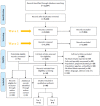Assessing the association between natural food folate intake and blood folate concentrations: a systematic review and Bayesian meta-analysis of trials and observational studies
- PMID: 25867949
- PMCID: PMC4425166
- DOI: 10.3390/nu7042663
Assessing the association between natural food folate intake and blood folate concentrations: a systematic review and Bayesian meta-analysis of trials and observational studies
Abstract
Folate is found naturally in foods or as synthetic folic acid in dietary supplements and fortified foods. Adequate periconceptional folic acid intake can prevent neural tube defects. Folate intake impacts blood folate concentration; however, the dose-response between natural food folate and blood folate concentrations has not been well described. We estimated this association among healthy females. A systematic literature review identified studies (1 1992-3 2014) with both natural food folate intake alone and blood folate concentration among females aged 12-49 years. Bayesian methods were used to estimate regression model parameters describing the association between natural food folate intake and subsequent blood folate concentration. Seven controlled trials and 29 observational studies met the inclusion criteria. For the six studies using microbiologic assay (MA) included in the meta-analysis, we estimate that a 6% (95% Credible Interval (CrI): 4%, 9%) increase in red blood cell (RBC) folate concentration and a 7% (95% CrI: 1%, 12%) increase in serum/plasma folate concentration can occur for every 10% increase in natural food folate intake. Using modeled results, we estimate that a natural food folate intake of ≥ 450 μg dietary folate equivalents (DFE)/day could achieve the lower bound of an RBC folate concentration (~ 1050 nmol/L) associated with the lowest risk of a neural tube defect. Natural food folate intake affects blood folate concentration and adequate intakes could help women achieve a RBC folate concentration associated with a risk of 6 neural tube defects/10,000 live births.
Figures




References
-
- National Institutes of Health: Office of Dietary Supplements Folate. [(accessed on 4 September 2014)]; Available online: http://ods.od.nih.gov/factsheets/Folate-HealthProfessional/
-
- Institute of Medicine . Dietary Reference Intakes for Thiamin, Riboflavin, Niacin, Vitamin B6, Folate, Vitamin B12, Pantothenic Acid, Biotin, and Choline. National Academy Press; Washington, DC, USA: 1998. - PubMed
-
- Gibson R.S. Principles of Nutritional Assessment. 2nd ed. Oxford University Press; New York, NY, USA: 2005.
-
- World Health Organization . Serum and Red Blood Cell Folate Concentrations for Assessing Folate Status in Populations. World Health Organization; Geneva, Switzerland: 2013.
Publication types
MeSH terms
Substances
LinkOut - more resources
Full Text Sources
Other Literature Sources
Medical
Miscellaneous

